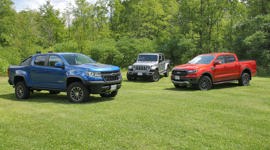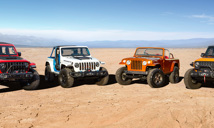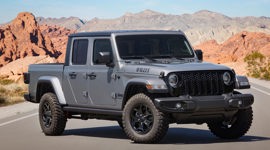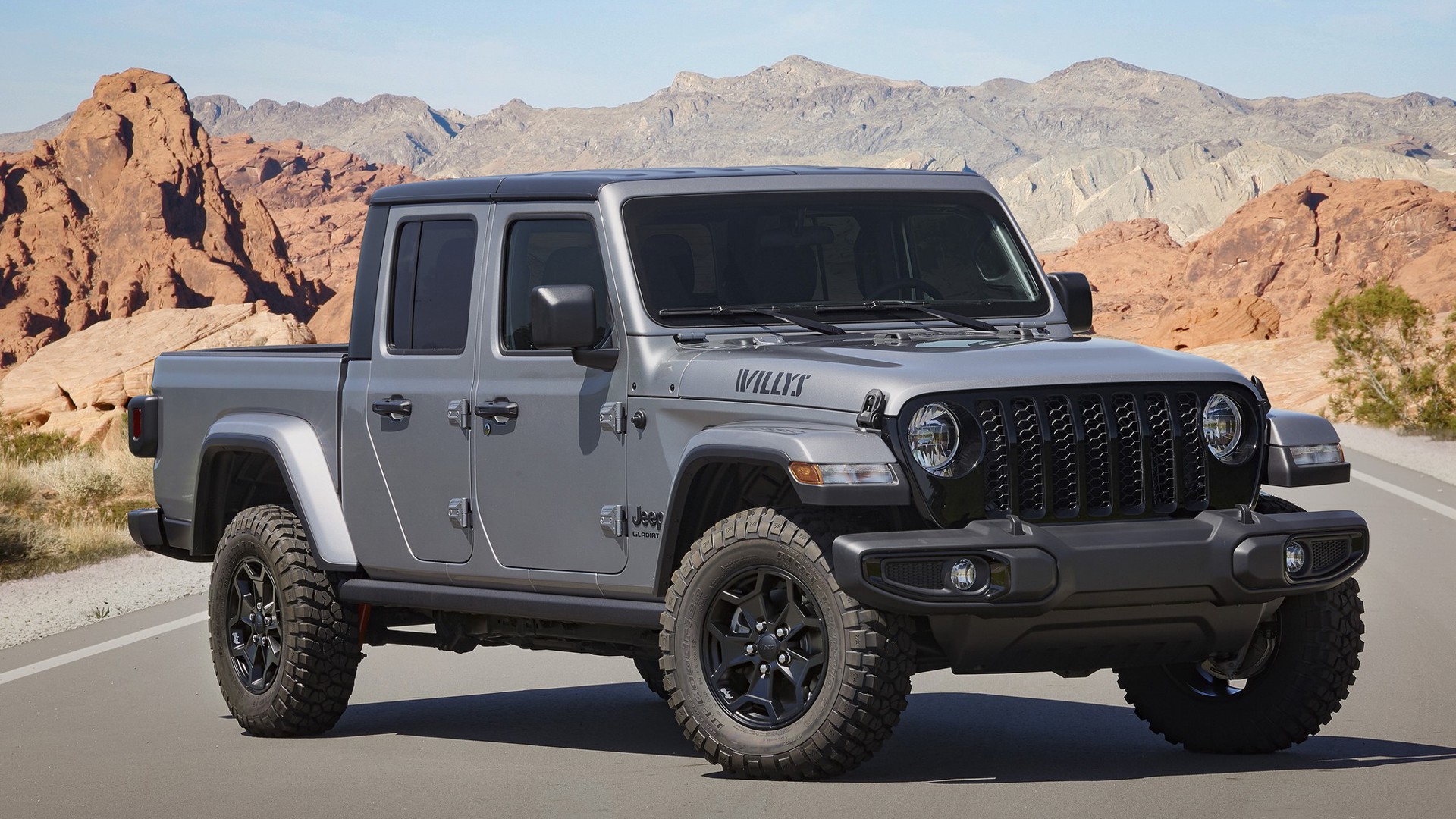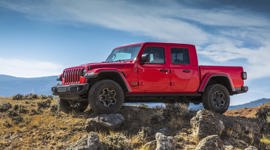As a part of the constant one-upmanship throughout the auto industry, there’s a burgeoning performance truck category – initiated several years ago by Ford’s trophy-truck-wannabe Raptor. It’s since been followed to a lesser degree by Chevy’s smaller Colorado ZR2 and Toyota’s Tacoma TRD Pro.
I’ve driven each of those rigs off-road in various settings they’re not only impressively capable pounding over ruts and rocks, but they’ve also got decent manners on-road, too. As butch as those trucks are, none of them come close to the rock-crawling capability of Jeep’s Gladiator pick-up in Rubicon form. The level of suspension articulation, and the solid feel of the Gladiator enables it to get places, or at least over things, those other trucks can’t.

Now there’s a new Gladiator Mojave trim, and it’s supposed to be different. It’s still an off-road-ready truck, but Jeep has modified this one to do things no other Gladiator can: off-roading at speed.
The Mojave forgoes Jeep’s vaunted Trail Rated fender badge for a Desert Rated one (the only Jeep so far with one), emphasizing Jeep’s priority for ride control and stability, sand and dirt traction, and “Desert Prowess”. The suspension articulation for low-speed rock-crawling, and deep-water fording considerations from the Trail Rated Jeeps apparently aren’t as important when blasting across the wide-open arid terrain.
With the fundamentals of the Gladiator unchanged (there’s still no independent suspension in the Mojave), how different can it possibly be from the Rubicon? As it happens, sufficiently so to make one question a Rubicon purchase.

The most notable change is the set of Fox 2.5-inch shocks (up from Fox 2.0s on the Rubicon) that feature an internal bypass to help them keep their cool on repeated high-speed and high-temperature bouncing. These shocks are similar to the setup in the Raptor, but Jeep goes a step further with additional Fox hydro jounce bumpers. Essentially these are a high-tech version of the bump stops that everyone else has, and it gives the Mojave an extra bit of padding when truck is hammering over moguls, prevent the suspension from crashing into the frame with brain-rattling force.
Jeep also adds an extra inch of ride height over other Gladiators, plus heavier cast-iron suspension knuckles, and the axle walls are thickened from 7 mm to 10 mm to add to the durability of sustained off-roading at higher speeds. The track is also wider on the Mojave thanks to a different offset on the trim-specific wheels.
Beyond that, there’s not much here that can’t be found in other Gladiators, making the Mojave’s suspension upgrade a no-brainer over the Rubicon, especially considering both trims start at the same $54,845 entry point.

But hold on, there are a few things missing from the Mojave. For one, the electronically disconnecting sway bar that lets the Rubicon extend its suspension reach to cartoonish levels is absent, and so is the front differential locker, both of which are considered necessary for serious rock crawling, not desert strafing. The Mojave shares its gearing with the Sport and Overland trim Gladiators, enabling a higher speed in 4-Lo gear to the Rubicon’s impossibly slow craw capabilities.
All of the Gladiators I’ve driven before skitter and bounce around whenever rutted or washboard roads are taken at anything approaching speed. The Mojave, by comparison, maintains its composure better over those higher-speed, and higher-frequency bumps reinforcing the real-world value of that suspension upgrade.
On the road, the tall Rubicon and Mojave both wander around enough to require nearly constant steering corrections. Add in squishy off-road-ready tires, and a greater susceptibility to crosswinds from the elevated ride heights and brick-like profile, and potential buyers should carefully evaluate how much they plan to actually take their truck off-road. Unless it’s planned to be a regular occurrence, other trucks including a Gladiator Overland or Sport will have somewhat better on-road manners, yet still go farther off the beaten path than most other machines.

On the eastern half of this continent, there isn’t a heck of a lot of desert to race around, so I took the Mojave down a trail to see how it fares on the Rubicon’s turf.
A few times when climbing some rocky steps, I had wished for the Rubi’s lower crawl speed, but it’s not like it was bounding wildly at idle speed in 4-Lo. Likewise, the deepest water crossing I faced was no issue, especially considering the Mojave sits taller than the Rubicon, and their air intakes are situated in the same spot within the engine bay anyway.
The Mojave threatened to high-centre on a few rocky spots along the trail where my trail-mate in a Wrangler JK Unlimited managed without incident. In fairness this has to do with the Gladiator’s extremely long wheelbase and poor breakover angle that applies to all models of Jeep’s truck, not just the Mojave. Fortunately, the Gladiator’s belly is moderately protected with some skid plates that were put to good use.

Beyond its off-road prowess and its ability to strip off its doors and roof, the Gladiator is a decently practical mid-sized pick-up too. Often times the aggressive suspension packages on trucks limit their towing capabilities. Here, it matters more which engine or transmission is selected with the Rubicon and Mojave each being rated at 2,041 kg (4,500 lb) with the six-speed manual transmission; 3,175 kg (7,000 lb) for the Rubicon with the 3.6L V6 and the eight-speed automatic versus the Mojave’s 2,948 kg (6,500 lb); but with the Eco Diesel, the Rubi is limited to 2,722 kg (6,000 lb).
The Mojave certainly grabs attention, too – even painted in the appropriate but rather drab Gobi beige colour – especially from other folks in lifted pick-ups. Maybe it was the orange tow hooks and trim, or the faux hood scoop that caught their eye.
Few vehicles have generated as polarized a response as Jeep’s Gladiator. There are those who criticize its awkward styling, or considerable cost relative to the competition (though a Chevy Colorado ZR2 Bison rings in pretty close to the Mojave’s list price, and a Raptor starts much higher). There are others who adore the truck version of the legendary Wrangler. Fan or foe, everyone agrees it’s a unique offering in the mid-sized pick-up class.

Having been thoroughly impressed by my time off-roading in the Gladiator Rubicon, I admittedly approached the Mojave with a bit of trepidation. Why take a heavy, lumbering truck with solid axles and try to make it better-suited for higher-speed off-roading, while degrading its rock-crawling capability?
After logging miles both on-road and off, I get it now. The Gladiator, due particularly to its long wheelbase, is a compromised rock-crawler anyway, despite how good the Rubicon trim is. It’s outstanding by pick-up truck standards, but compared to a Wrangler, it pales. To that end, giving up the few features that give the Rubicon the potential for superior crawling has less effect on its actual off-road function than its physical dimensions do. Plus, the Mojave still betters the competition on rocky trails, but can now also handle higher-speed work the way the Colorado ZR2 or Tacoma TRD Pro do.
The Mojave’s upgraded suspension and more durable parts that can better take a pounding make this the trim to have. I’d have my Mojave in Gator green with the diesel, please.























